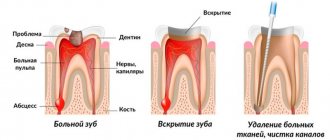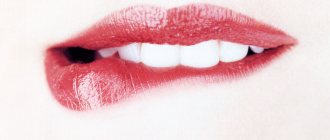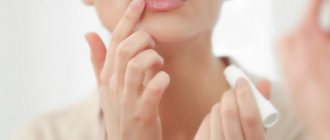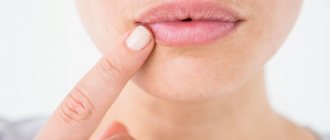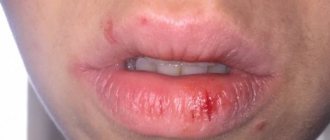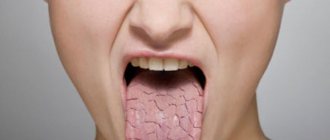( 5 ratings, average: 3.40 out of 5)
Home » Fungal diseases
Changes in weather, disruptions in the body - all this can provoke unexpected manifestations on the face. These “effects” include cracks in the corners of the mouth (angular cheilitis), which worsen in winter and cold autumn. They are in no hurry to disappear, since the reason may not be simple. The secondary appearance of jams requires serious treatment.
Causes and contributing factors for the appearance of cracks
The first reasons for the development of cracks in the corners of the mouth are red spots in the corners of the lips. Soreness will follow.
The appearance of cracks is influenced by various factors. They are infectious, traumatic or fungal in nature, etc.
Traumatic
A wound on the edges of the lips occurs after a visit to the dentist. If the doctor used the instruments aggressively, then damage will not be long in coming. With frequent visits to the dentist, angulitis does not have time to drag on. Problems are often observed with constant wearing of a prosthesis.
It is the corners of the lips that suffer due to friction of the structure. If the lips are prone to dryness, clefts occur when screaming, yawning, or passionate kissing. You can find out the cause of such a seizure by remembering a recent trip to the doctor.
Infectious
Injury due to improper hygiene. With chronic trauma to the corners of the mouth, infections occur. Whether children or adults, everyone can be affected by the germ. This is facilitated by a reluctance to wash hands and put dirty objects in the mouth. Those who do not brush their teeth often experience angular wounds.
If dirt gets on your lips, the inflamed area becomes crusty and begins to bleed. Almost always the wound goes to the pharynx and chin.
Fungal infections
Candidiasis on the corners of the mouth is called “yeast infection” among specialists. Fungi multiply after a recent cold, diabetes, and gastrointestinal pathologies.
Long-term use of antibiotics also contributes to their occurrence. In this case, whitish erosion is observed, the plaque from which is removed by scraping.
Initial manifestations of syphilis
With this disease, a hard lump is disguised as cheilitis. This is an element of the initial stage of the disease. If left untreated, it will turn into secondary syphilis.
Angulitis becomes covered with a grayish coating without pain when touched. When a streptococcal infection occurs, the chancre becomes painful even when opening the mouth. A thickening occurs in the affected area.
Tuberculosis
Adult patients sometimes develop clefts in the corners of the lips. It signals active pulmonary tuberculosis. The person’s condition is serious, so such manifestations do not attract attention.
In this case, the ulcer on the corners of the mouth will be painful with undermined edges. The condition is unsatisfactory.
Bad habits
The appearance of clefts in the corners of the mouth is caused by habits such as licking, drinking alcohol, and smoking. In addition, regularly keeping foreign objects in the oral cavity contributes to the development of angular stomatitis.
With uncontrolled consumption of strong drinks, the body is weakened, which provokes an exacerbation of diseases in remission. They also affect the integrity of the skin. After stopping bad habits, seizures stop appearing.
Allergic, weather
Allergy to toothpaste, lipstick; extreme heat and wind can cause cracks to appear. If seizures occur against the background of these factors, then the skin around the ulcer will peel off.
Hypovitaminosis
A common cause of cheilitis is a lack of vitamin B2. Hypovitaminosis occurs if there are problems with the intestines and poor absorption of the beneficial element.
Vitamin deficiency can also be accompanied by clefts. With a severe lack of them in the body, ulcers spread to the lips, swelling, redness, and inflammation of the tongue appear.
General diseases
Angular cheilitis is a symptom of iron deficiency. If there are problems with the endocrine system and the presence of HIV infection, the cause of angulitis is the proliferation of yeast fungi.
It is easy to recognize such pathologies:
- Anemia – weakness, pale skin, light mucous membrane in the mouth, burning tongue;
- Endocrine pathologies – dry mucous membranes, gum problems;
- HIV – oral candidiasis, ulcerative gingivitis.
Atopic cheilitis
If a schoolchild often suffers from inflammation, and his parents also struggled with this in adolescence, then we are talking about atopic cheilitis. The disease belongs to neurodermatology, occurring due to hormonal imbalances and abnormalities in the functioning of the nervous system.
Such a jam develops together with redness and small clefts in the middle. The ulcer is red, the lips are swollen and dry.
Chronic recurrent fissure of the corner of the mouth
A chronic fissure occurs against the background of general pathologies and neurogenic mechanisms. Psycho-emotional trauma often contributes to this. The crack becomes covered with a red, soft crust with slight pain. The psychosomatics of the disease is diagnosed by a qualified doctor.
Cracks in the corners of the mouth are a sign of a lack of nutrients. This is easy to recognize by the presence of weakness, increased fatigue, and intense hair loss.
Types of angulite
Considering the etiology, seizures can be primary and secondary. In turn, the primary ones are divided into: streptococcal, viral and candidiasis.
Viral seizures. They are caused by a viral infection (herpes virus). In this case, a doctor will help you choose an ointment for sticking in the corners of an adult’s lips.
Streptococcal seizures are caused by streptococcal infection. A characteristic manifestation is the formation of a yellowish-red crust.
Candidiasis angulitis. The cause is a fungal infection. This type is characterized by a chronic course and the absence of a crust.
Treatment
The method of treating angulitis depends on the reasons that provoked its appearance. What to do in the event of the development of a serious pathology - to treat yourself or go to a doctor - is decided by the person himself. In the absence of proper treatment, cheilitis can turn into purulent abscesses.
- Trauma, bad habits. Correct the prosthesis, temporarily avoid going to the dentist, do not perform active actions with the throat and lips, take proper care of the oral cavity, and brush your teeth thoroughly. It is recommended to numb the surface with lidocaine-based solutions. Treat with antiseptics, stimulate healing with rosehip or sea buckthorn oils. It is also not forbidden to use cream for dryness and flaking.
- Leukoplakia. Stop smoking, eliminate spicy foods from your diet. For therapy, use a solution of vitamin A (topically), E, B6 - orally for 30 days.
- Candidiasis. Apply Lamisil cream three times a day to the crack. Consultation with a specialist is recommended.
- Tuberculosis. Treatment against the background of tuberculosis is carried out in conjunction with the main therapy. Cracks in the corners of the lips are eliminated with an antiseptic and anti-tuberculosis drugs. In such a situation, a person complains that the corners of his lips hurt.
- Syphilis. Therapy is similar to tuberculosis. As an addition, agents to eliminate candidiasis can be used.
- Allergy. The use of antiallergic drugs externally and internally. Termination of exposure to the irritating factor.
- Weather. Reducing time spent outdoors, using lip liner. Treatment with Bepanten, Panthenol.
- Hypovitaminosis B2. Taking B vitamins, visiting a specialized doctor. Rosehip oil and Solcoseryl are used for healing.
- Anemia, thyroid disease, HIV infection. Treatment is carried out taking into account the local picture. Similarly with therapy for candidiasis and leukoplakia.
- Atopic cheilitis. A diet excluding alcohol, sweets, and fatty foods. Taking antiallergic drugs, vitamins. Anesthesia, use of antiseptics, use of steroid liniments: adults – Lorinden-S; children - Traumeel-S.
- Chronic recurrent crack. Maintaining oral hygiene, bandages with solcoseryl, correction of emotional background, treatment of concomitant pathologies.
You should forever give up the habit of licking your lips outside in windy weather.
Folk remedies
Many people are treated with folk remedies, which sometimes drive themselves into a serious trap. Despite the harmlessness of irritation in the pharynx area, it can cause irreparable harm to the body.
- Ear wax will help with cracks in the corners of your mouth. You need to take it out with a cotton swab and lubricate the angulite. This method is also effective for herpes.
- Thermal water is also a good helper in the fight against cracks. An analogue of such treatment is hygienic lipstick. 5-6 times a day is enough for the wounds to begin to heal and go away.
- Goose fat, beeswax, and Vaseline are used for angulitis on the corners of the pharynx. Olive, rose hip, tea tree, and sea buckthorn oils are effective. Infusions of chamomile, calendula, and sage help. To soften the surface of the crust on the crack, it is smeared with honey or butter.
- A common folk remedy for wounds on the corners of the mouth is the juice of Kalanchoe leaves, fresh stems of celandine, plantain, and garlic. The disadvantage of this treatment is the possible burning sensation. It shouldn't be scary.
- Use hair that needs to be rubbed every day along the edges of the lips. Perhaps the method helps, to each his own. They also use the dull side of a knife to remove cracks. They are passed over the inflamed area several times a day.
Features of therapy and prevention
Best materials of the month
- Coronaviruses: SARS-CoV-2 (COVID-19)
- Antibiotics for the prevention and treatment of COVID-19: how effective are they?
- The most common "office" diseases
- Does vodka kill coronavirus?
- How to stay alive on our roads?
Therapy is based on eliminating the root cause of the seizure, but there are also general recommendations for caring for the affected skin. If the cracks are streptococcal in nature, ointments with antibiotics are additionally administered, and if they are fungal, ointments with an antifungal effect are administered. The skin around the crack must be regularly treated with disinfectant solutions to avoid re-development of the source of infection. After eliminating the root cause, therapy continues for another 7-10 days until the skin is completely restored.
Depending on the root cause of angulitis, the course of treatment may include the use of antibiotics, B vitamins or paraffin-based ointments. In most cases, the prognosis is favorable. The main thing is not to self-medicate, consult a doctor in a timely manner and follow all necessary recommendations.
